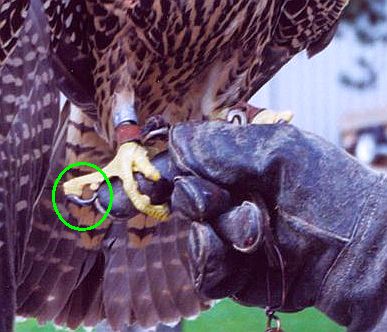 How do raptors catch their food?
How do raptors catch their food?
With their talons.
Talons are the claws on birds of prey and one of the two body parts that identify them as raptors, the other being their sharp beaks.
On peregrines, the talons are especially long and deadly.
The photo at left shows a peregrine’s feet on a rehabber’s glove with one talon circled in green. See how long and curved that talon is? About 3/4″ long. Nearly as long as the first joint of the rehabber’s finger.
And whose talon is this?
Click on the photo to see PittStop, a female peregrine born at the Gulf Tower in 2003 who injured her wing when she hit a building that July. She was taken to Medina Raptor Center in Spencer, Ohio and underwent flight training in the spring of 2004 to regain her wing strength after her initial injury healed. That’s when this photo was taken.
Unfortunately Pittstop’s injury was too extensive. Her wing always droops, she cannot fly well enough to hunt, and she sometimes has damage-related seizures.
Pittstop is now an educational bird at Median Raptor Center. I’m glad they were allowed to keep her.
(photo by Chad+Chris Saladin, altered to illustrate the feet and talons)
What a beautiful bird. Glad she can be used for education. There is so much to be learned about raptors.
Are there only 4 babies left at the cathedral?
Well, she certainly cuts a beautiful figure, injured or not. I’m glad she is in a safe place, teaching others about Peregrines.
The fifth baby at the cathedral was hiding under the front of the box.
Yes, the nestlings at the Cathedral of Learning are now old enough to walk out of camera range. When we look at them through the webcam we think we can see everything. We don’t realize there are hiding places until a nestling goes there.
I just saw Dori eat an egg shell. Did she eat a chick? I thought I heard the sound of a chick yesterday, Saturday. I haven’t had much time to watch this seek. Are the males still helping, and are the chicks in danger of the wind and cold?